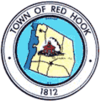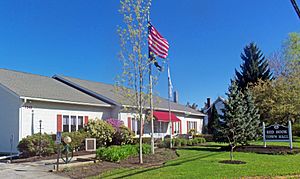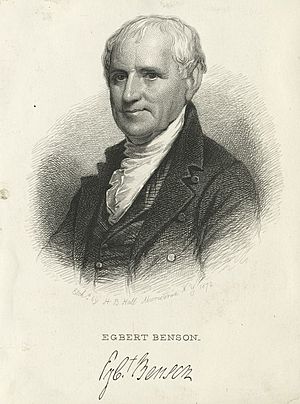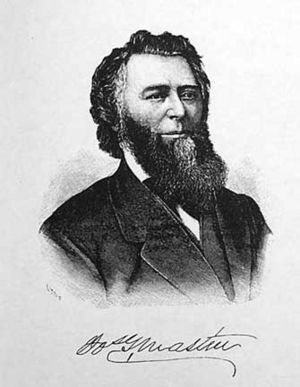Red Hook, New York facts for kids
Quick facts for kids
Red Hook, New York
|
|||
|---|---|---|---|
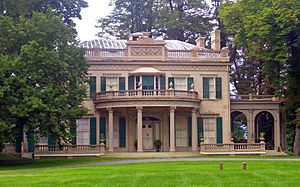
|
|||
|
|||

Location of Red Hook in Dutchess County, New York (left) and of Dutchess County in New York state (right)
|
|||
| Country | United States | ||
| State | New York | ||
| County | Dutchess | ||
| Established | 1812 | ||
| Government | |||
| • Type | Town Council | ||
| Area | |||
| • Total | 40.04 sq mi (103.70 km2) | ||
| • Land | 36.17 sq mi (93.68 km2) | ||
| • Water | 3.87 sq mi (10.03 km2) | ||
| Elevation | 203 ft (62 m) | ||
| Population
(2020)
|
|||
| • Total | 9,953 | ||
| • Density | 248.57/sq mi (95.97/km2) | ||
| Time zone | UTC−5 (Eastern (EST)) | ||
| • Summer (DST) | UTC−4 (EDT) | ||
| ZIP Codes |
12504, 12507, 12571
|
||
| Area code(s) | 845 | ||
| FIPS code | 36-027-60905 | ||
| GNIS feature ID | 0979411 | ||
Red Hook is a town located in Dutchess County, New York, United States. In 2020, about 9,953 people lived there. The town's name might come from the red leaves on trees found on a small piece of land near the Hudson River.
Red Hook includes two villages: Red Hook and Tivoli. It also has two smaller communities called hamlets. Bard College is in the hamlet of Annandale-on-Hudson. The Unification Theological Seminary is in Barrytown. Both of these hamlets are part of the important Hudson River Historic District.
Contents
The History of Red Hook
The first people to live on this land were the Mohican, Munsee, and Lenape tribes. When Europeans began to settle here, Native American tribes were very important to the local economy. They traded beaver furs with the European settlers.
Europeans brought new things like cattle, horses, and sheep. Sadly, enslaved African American people were also brought to the area. These new species and human activities greatly changed the natural environment.
Native American tribes like the Lenape had different ideas about land ownership than the European settlers. The Lenape believed that the Earth was created for everyone and everything. This meant land could not be owned by one person or used only for profit. They did not fully understand selling land. They thought they would still be able to hunt, fish, and farm on it.
In 1688, a Dutch settler named Peter Schuyler bought two areas of land from native peoples. One of these was near Red Hook. The original name for one of these places was given in the Munsee language.
Before 1812, Red Hook was part of the town of Rhinebeck. The state government decided to split these towns because they had grown too large. This made it easier for people to attend town meetings. The first official meeting for the Town of Red Hook was held on April 6, 1813. It took place in a local inn. The Red Hook Society for the Apprehension and Detention of Horse Thieves is one of the oldest groups in New York and still meets every year.
Where is Red Hook? (Geography)
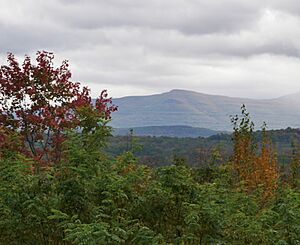
Before Europeans arrived, the land around the Hudson River had forests, meadows, and streams. This natural beauty was often shown in art as a wild American landscape. These pictures sometimes made it seem like no Indigenous people lived there. However, Native Americans enjoyed this same land long before settlers came.
When settlers arrived, they changed the landscape by building mills and distilleries. Today, other changes include the development of Tivoli North Bay and Stony Creek watershed. The Stockbridge-Munsee Band of Mohicans have said that Dutchess County, including Red Hook, is an important area for finding old artifacts.
The town of Red Hook covers about 103.7 square kilometers (40.04 square miles). About 93.7 square kilometers (36.17 square miles) is land, and 10.0 square kilometers (3.87 square miles) is water. The northern border of Red Hook is the line for Columbia County. The western border is the middle of the Hudson River, which separates it from Ulster County.
Learning in Red Hook (Education)
The town of Red Hook has its own school district. This district also includes parts of the nearby towns of Milan and Livingston.
- Students in pre-kindergarten to fifth grade go to Mill Road Elementary School.
- Students in sixth to eighth grade attend Linden Avenue Middle School.
- Students in ninth to twelfth grade go to Red Hook High School.
Most graduates from Red Hook High School (over 80%) continue their education at colleges.
| School | Grades |
|---|---|
| Mill Road Elementary School | Kindergarten to 5th |
| Linden Avenue Middle School | 6th to 8th |
| Red Hook High School | 9th to 12th |
Bard College is a private college in the hamlet of Annandale-on-Hudson. It was started in 1860 and offers programs for both undergraduate and graduate students.
Fun Things to Do in Red Hook (Culture)
Many parts of Bard College are open for everyone to enjoy.
- You can attend events at the Bard Conservatory of Music, held at the Fisher Center for the Performing Arts.
- Visit the Hannah Arendt Center for Politics and Humanities.
- Explore the Hessel Museum of Art at Bard College.
The Old Rhinebeck Aerodrome is a museum with old airplanes. It is located in the southeast part of Red Hook.
Poets' Walk Park is in the southwestern part of Red Hook. It was designed by Hugo Jacob Ehlers. This park is managed by the Scenic Hudson Land Trust and offers great views of the Hudson River.
Population of Red Hook
| Historical population | |||
|---|---|---|---|
| Census | Pop. | %± | |
| 1820 | 2,714 | — | |
| 1830 | 2,983 | 9.9% | |
| 1840 | 2,829 | −5.2% | |
| 1850 | 3,264 | 15.4% | |
| 1860 | 3,964 | 21.4% | |
| 1870 | 4,350 | 9.7% | |
| 1880 | 4,471 | 2.8% | |
| 1890 | 4,388 | −1.9% | |
| 1900 | 3,895 | −11.2% | |
| 1910 | 3,705 | −4.9% | |
| 1920 | 3,218 | −13.1% | |
| 1930 | 3,404 | 5.8% | |
| 1940 | 3,405 | 0.0% | |
| 1950 | 4,219 | 23.9% | |
| 1960 | 6,023 | 42.8% | |
| 1970 | 7,548 | 25.3% | |
| 1980 | 8,351 | 10.6% | |
| 1990 | 9,565 | 14.5% | |
| 2000 | 10,408 | 8.8% | |
| 2010 | 11,319 | 8.8% | |
| 2020 | 9,953 | −12.1% | |
| U.S. Decennial Census | |||
In 2010, there were 11,149 people living in Red Hook. The population included people of different backgrounds:
- Most people (90.1%) were white.
- About 1.44% were African American.
- About 0.50% were Native American.
- About 3.3% were Asian.
- About 6.7% of the population were Hispanic or Latino.
The median age in the town was 36 years old.
Towns and Places in Red Hook
Here are some of the communities and places you can find in the town of Red Hook:
- Annandale-on-Hudson: This hamlet is in the northwest part of town, by the Hudson River. Students from Bard College often visit the villages of Tivoli and downtown Red Hook.
- Bard College: A college located in the northwestern part of the town.
- Barrytown: A hamlet south of Annandale-on-Hudson.
- Cokertown: A hamlet in the northeastern part of the town.
- College Park: A neighborhood east of Bard College.
- Forest Park: A neighborhood in the southern part of the town.
- Fraleighs: A hamlet in the eastern part of the town.
- Kerleys Corners: A hamlet near the northern town line.
- Linden Acres: A neighborhood northwest of Red Hook village.
- Red Hook: This is the main village within the town.
- Red Hook Mills: A hamlet north of Red Hook village.
- Spring Lakes: A small hamlet.
- Tivoli: This village is in the northwestern part of the town, by the Hudson River.
- Upper Red Hook: A hamlet north of Red Hook village.
Getting Around Red Hook (Transportation)
Roads
U.S Route 9 goes north and south through Red Hook. New York State Route 9G also runs north and south, passing through villages near the Hudson River. New York State Route 199 goes east and west through the town. It crosses the Hudson River towards Kingston, New York.
Railroad
Until 1956, trains from the New York Central Railroad used to stop at Barrytown's station. These trains traveled between Albany and New York City. By 1960, trains no longer stopped at Barrytown.
Famous People from Red Hook
Many notable people have lived in or are connected to Red Hook, including:
- Hannah Arendt, a famous philosopher and writer.
- Egbert Benson, who was the first Attorney General of New York.
- Dorothy Day, who started the Catholic Worker Movement.
- Stephen Hickman, an artist.
- George E. Jonas, who founded Camp Rising Sun, a summer leadership program.
- Robert Kelly, a poet.
- Alison Knowles, an artist known for her work in the Fluxus movement.
- Brice Marden, a well-known abstract painter.
- Joseph G. Masten, who served as mayor of Buffalo.
- John Morris, a composer for films and TV.
- Peter Serkin, a classical pianist.
- Robert Sheckley, a science fiction writer.
- Gore Vidal, a famous writer and public thinker.
See also
 In Spanish: Red Hook (Nueva York) para niños
In Spanish: Red Hook (Nueva York) para niños



